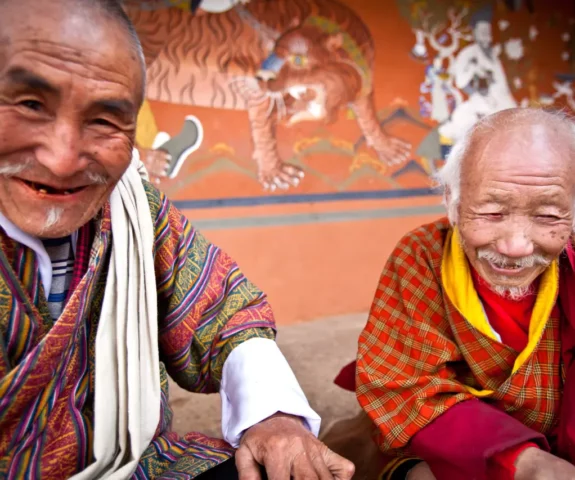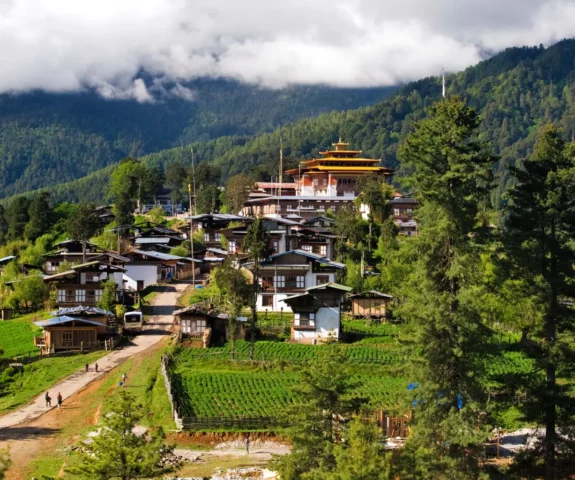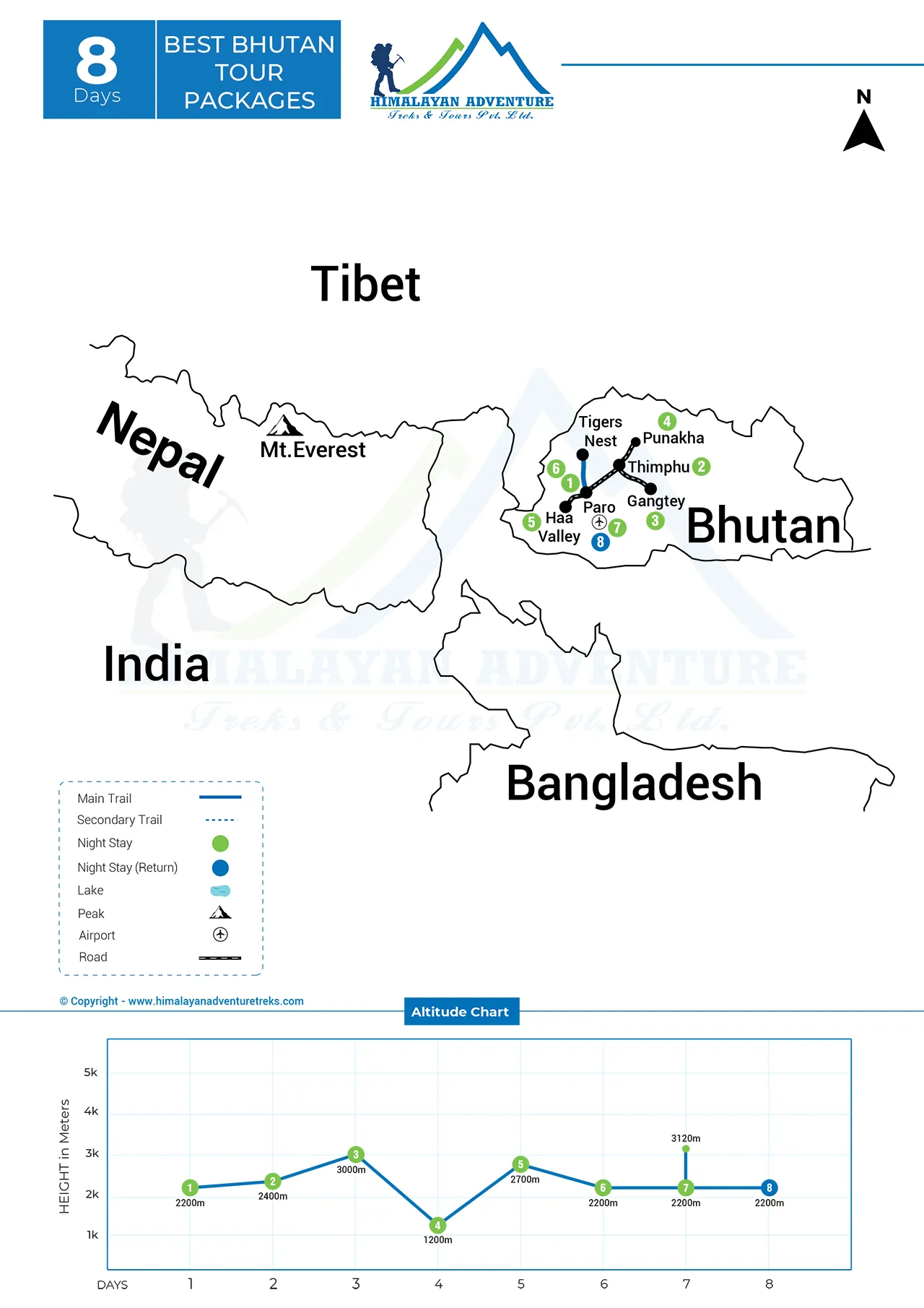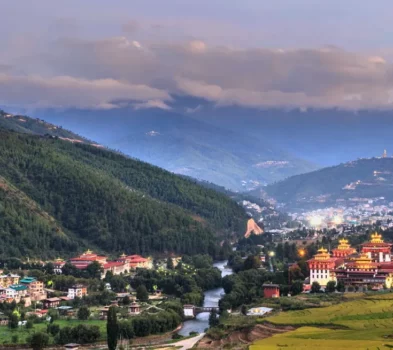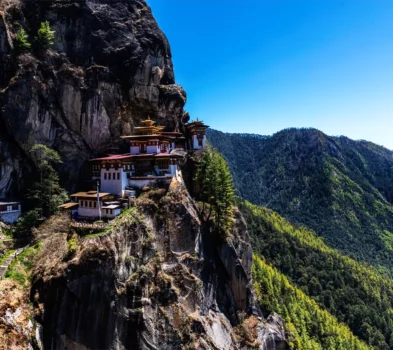Duration
8 DaysBest Bhutan Tour Packages
Trip Grade
EasyGroup Size
1-16 PeopleMax Altitude
4,000m. / 13,123ft.Best Season
Feb- May/ Sept- NovActivity
Long TourMeals
Breakfast, Lunch & DinnerAccommodation
Hotels & ResortTransportation
Private VehicleTrip Customization
On request (click here)Highlights of Best Bhutan Tour Packages
-
Tiger’s Nest Monastery (Paro): Hike to the iconic Tiger’s Nest Monastery, Bhutan’s most sacred site perched dramatically on a cliff, a must-see in any Paro tour package.
-
Punakha Dzong (Punakha): Explore the stunning Punakha Dzong, known as the “Palace of Great Happiness,” a major highlight of Bhutan cultural tours.
-
Haa Valley Exploration: Discover the untouched beauty of Haa Valley, a hidden gem perfect for offbeat Bhutan travel and rich in traditional Himalayan culture.
-
Buddha Dordenma & Memorial Chorten (Thimphu): Visit Thimphu’s towering Buddha Dordenma and spiritual Memorial Chorten, both key attractions in Thimphu sightseeing tours.
-
Gangtey & Phobjikha Valley: Witness endangered black-necked cranes in the serene Gangtey Valley, a top destination in Bhutan eco-tourism and nature tours.
-
Dochula Pass with 108 Chortens: Stop at Dochula Pass to see the 108 chortens and panoramic views of the Himalayas, a scenic highlight in most Bhutan road trips.
-
Cultural Experience with Festivals or Farmhouse Visit: Immerse in local life by attending a vibrant mask dance festival or enjoying a traditional farmhouse stay in Bhutan.
Trip Introduction
Best Bhutan Tour Packages – Discover the Thunder Dragon Kingdom, Bhutan, a small yet extraordinary Himalayan kingdom, is nestled deep within the Eastern Himalayas, bordered by India to the south and China (Tibet) to the north, making it a perfect destination for those seeking an unforgettable Bhutan holiday package.
For centuries, Bhutan remained in self-imposed isolation, not just due to its rugged geography but as a deliberate decision by its kings to preserve its rich Mahayana Buddhist culture, setting the stage for one of the most authentic cultural tours in Bhutan.
Uniquely, Bhutan is one of the few nations in Asia that was never colonized, maintaining full sovereignty and independence, which is why travelers interested in untouched traditions and authentic Himalayan experiences often seek the best Bhutan package tour.
With a population of about 700,000, the Bhutanese people live in deep harmony with nature, guided by the principles of Drukpa Kagyu Buddhism, a branch of Tibetan Buddhism, forming the spiritual foundation of every Bhutan guided tour.
As the world’s only Mahayana Buddhist kingdom, Best Bhutan Tour Packages emphasizes compassion and the protection of all sentient beings, leading to progressive policies that make it the world’s only carbon-negative country, ideal for eco-friendly travel in Bhutan.
More than 70% of Bhutan’s land is covered by forests, and its commitment to environmental conservation has made it a role model in sustainable tourism, attracting nature lovers booking green Bhutan travel packages.
Popular destinations included in the best Bhutan Package tour packages itinerary—such as Paro (Tiger’s Nest Monastery), Thimphu, Punakha, Haa Valley, and Gangtey Valley—offer travelers a chance to explore sacred monasteries, panoramic mountain passes, black-necked crane habitats, and vibrant Bhutanese festivals, making it a once-in-a-lifetime cultural and spiritual adventure.
Outline Itinerary of Best Bhutan Tour Packages
Day 01: Arrive Paro by flight.
Day 02: Thimpu Sightseeing.
Day 03: Drive from Thimpu to Gangtey.
Day 04: Drive from Gangtey to Punakha.
Day 05: Drive from Punakha to Haa Valley
Day 06: Drive from Haa Valley to Paro.
Day 07: Taktshang Monastery Hike.
Day 08: Departure to Airport.
Our guests sharing their experiences (Photo/Video Gallery)
Detail itinerary of Best Bhutan Tour Packages
Day 01: Arrive Paro by flight.
The flight to Paro is one of the most spectacular in entire Himalayas. Flying along the Himalayan range from Kathmandu, the journey offers fascinating views and an exciting descent into the Kingdom. Bhutan’s first gift, as you disembark from the aircraft will be cool, clean fresh mountain air. After immigration formalities and baggage collection, you will be met by our guide and afterwards drive to Thimphu, the capital town of Bhutan with enroute stop at Chuzom, the confluence of Thimphu and Paro rivers. Three different style of stupas; Tibetan, Nepalese and Bhutanese adorn this confluence. Shortly before reaching Chuzom, you will see on your left TschogangLhakhang, “the temple of the excellent horse”. It is a private temple, built in 15th century, as the result of visitation from Balaha, the excellent horse, a manifestation of Chenrezig, the compassionate Buddha.
On arrival in Thimphu, check into the hotel. The capital town of Bhutan and the centre of Government, religion and commerce, Thimphu is a unique city with unusual mixture of modern development alongside ancient traditions. With the population of about 90,000 it is perhaps still the world’s only capital city without a traffic light.
Evening an exploratory walk around Thimphu Main Street and market area. Also, visit the Local Crafts Bazaar, to browse through example of Bhutan’s fine traditional arts. Here you can buy hand-woven textiles, Thangkha paintings, masks, ceramics, slate and wood carvings, jewellery, interesting items made from local materials. Overnight at the hotel in Thimphu.
Activity: Airport Pickup & Sightseeing,4-5 hours
Max. Altitude: 2,400m/7,874ft. Paro
Meal: Lunch & Dinner
Accommodation: Hotel
Day 02: Thimpu Sightseeing.
After breakfast, visit Buddha Point (Kuensel Phodrang). Located at a short drive from Thimphu city centre, visitors can get a good overview of the Thimphu valley from the Buddha point (KuenselPhodrang). You can pay your obeisance and offer prayers to the Buddha, the largest statue in the country and then walk around and take a glimpse of the valley.
Commence the “Buddha Nature Train” from Buddha point to Changangkha Lhakhang (02 hours easy hike). The hike from Buddhapoint to Changangkha Lhakhang is the most popular one to see the locals of Bhutan and at the same time take a forest bath. As you hit the trail you will be greeted by thousands of prayer flags and welcomed by a pristine forest of pines, birch, and rhododendron trees. If you are lucky, you can encounter few wild pheasant and bore. The trail is well maintained and at some places along the trails Gazebos are set up from where you can have a spectacular view of Thimphu valley and ends at Changangkha Lhakhang.
Continue visit the Changangkha Lhakhang, which is a fortress like temple and monastic school perched on a ridge above Thimphu, south of Motithang. The temple was established in 12th century on a site chosen by Lama PhajoDrugomShigpo, who came from Tibet. The central statue here is Chenrezig in a manifestation with 11 heads. From temple courtyard, there is fascinating view of Thimphu valley.
After lunch, take a short drive (15 km) to Pangri Zampa, 16th century one of the oldest monasteries in Bhutan located just north of Thimphu. Here is a monastic school where Buddhist student’s monks learn Lamaism and astrology based on Buddhist philosophy.
Later, visit Trashichhoedzong: This impressive fortress/monastery houses Secretariat building, the throne room of His Majesty, the King and various government offices. It is also the summer residence of Chief Abbot and central monk body. Overnight at the hotel in Thimphu.
Activity: Sightseeing, 5-6 hours
Max. Altitude: 2,400m/7,874ft. Thimpu
Meal: Breakfast, Lunch & Dinner
Accommodation: Hotel
Day 03: Drive from Thimpu to Gangtey.
After breakfast, check-out from the hotel & drive Gangtey (Phobjikha) which takes about 5 hours and 150km,enroute visiting Dochula Pass (Altitude 3080m). In Bhutan, the passes are marked by a large Bhutanese Chorten and prayer flag. Dochula pass offers the most spectacular view over the high peaks of the eastern Himalayas on a clear day. And also via Wangdue Phodrang, where you can visit the local market and explore newly developed town. The district of Wangdue Phodrang is also famous for its bamboo products, slate and stone carvings. Further ahead pass through dense forests and oak, rhododendron tress, reaching at Gangtey (Phobjikha).
The valley of Gangtey is one of the most beautiful spots in Bhutan. The surprise of finding such a wide, flat valley without any trees after the hard climb through dense forests is augmented by an impression of vast space, and extremely rare experience in Bhutan where most of the valleys are tightly enclosed.
After lunch, take a walk around Gangtey village and visit Gangtey Goempa. Perched on a small hill that rises from the valley floor, the Gangtey Monastery is the only Nyingmapa monastery on the western side of the Black Mountain’s Gangtey valley, Bhutan and also the biggest Nyingmapa monastery in Bhutan. The Monastery is surrounded by a large village inhabited mainly by the families of the 140 Gomchens who take care of the Monastery. Overnight at hotel in Gangtey (Phobjikha).
Activity: Drive & Sightseeing, 7-8 hours
Max. Altitude: 3,080m/10,105ft. Gangtey
Meal: Breakfast, Lunch & Dinner
Accommodation: Hotel
Day 04: Drive from Gangtey to Punakha.
After breakfast, continue drive to Punakha, the old capital of Bhutan, about 75km and takes about 3 hours, enroute take a short walking excursion to Chimi Lhakhang, from hotel it is about 15 mins’ drive till motor able road and then walk starts through paddy fields and villages. This is total about 1½ hrs walk, including both way). The Chimi Lhakhang, situated on a hillock in the centre of the valley, also known as the temple of fertility. It is widely believed that couples who do not have children and wanting one, if they pray at this temple, they are usually blessed with a child very soon. The trail leads across rice fields to the tiny settlement of Pana, meaning ‘field’. A walk through the village near the temple will give you rare glimpses into the daily life and lifestyle of the villagers. Evening you may hang out at local markets.
You will visit The Punakha Dzong or the Pungtang Dechen Phortang Dzong is located at the confluence of the Mo Chhu and the Po Chhu River, combine to form the Puna Tsang Chu which in turn is a tributary of the mighty Brahmaputra River.
The Dzong was constructed by Zhabdrung Ngawang Namgyal Wangchuck in 1638. Overnight at hotel in Punakha
Activity: Drive & Sightseeing, 5-6 hours
Max. Altitude: 1,275m/4,183ft. Punakha
Meal: Breakfast, Lunch & Dinner
Accommodation: Hotel
Day 05: Drive from Punakha to Haa Valley
After breakfast, drive to Haa via Dochula, Semtokha to Chele-la pass (3800Mts / 12465Fts, 65 Kms / 02 to 03Hrs – One way).
Visit HaaDzong, Lhakhang Karpo, Lhakhang Nagpo, Wangchulo Dzong. Depending on the weather, Road conditions and time Haa excursion could be either taken from Chele-la Pass or from Chozum side one can also opt for going from Chele-la Pass and returning from Chuzom side or vice versa. Overnight hotel in Haa.
Activity: Drive & Sightseeing, 6-7 hours
Max. Altitude: 3,800m/12,467ft. Haa Valley
Meal: Breakfast, Lunch & Dinner
Accommodation: Hotel
Day 06: Drive from Haa Valley to Paro.
After breakfast, drive to Paro along scenic highway which is around 65km and takes about 2.5 hours, enroute visit Chelela Pass.
On arrival in Paro, check into the hotel. After lunch, proceed to visit Ta Dzong, originally built as Watchtower, which now houses National Museum. The extensive collection includes antique Thangkha paintings, textiles, weapons & armor, household objects and a rich assortment of natural and historic artifacts.
Ta Dzong visit immediately followed by a short walk down the trail to visit Rinpung Dzong (ParoDzong), meaning (“fortress of the heap of jewels”), which has a long and fascinating history. Along the wooden galleries lining the inner courtyard are fine wall paintings illustrating Buddhist lore such as four friends, the old man of long life, the wheel of life, scenes from the life of Milarepa, Mount. Sumeru and other cosmic Mandala.
Activity: Drive & Sightseeing, 6-7 hours
Max. Altitude: 3,988m/13,084ft. Paro
Meal: Breakfast, Lunch & Dinner
Accommodation: Hotel
Day 07: Taktshang Monastery Hike.
After breakfast excursion to Taktshang Monastery or Tiger’s Nest (approx. 5 hours walk): It is one of the most famous of Bhutan’s monasteries, perched on the side of a cliff 900m above the Paro valley floor. It is said that Guru Rinpoche arrived here on the back of a tigress and meditated at this monastery and hence it is called ‘Tiger’s Nest’. This site has been recognised as a most sacred place and visited by ShabdrungNgawangNamgyal in 1646 and now visited by all Bhutanese at least once in their lifetime. On 19 April, 1998, a fire severely damaged the main structure of building but now this Bhutanese jewel has been restored to its original splendor.
Afternoon drive to Drukgyel Dzong, a ruined fortress where Bhutanese warriors fought Tibetan invaders centuries ago. The snowy dome of sacred Chomolhari, “mountain of goddess” can be seen in all her glory from the approach road to the Dzong.
Evening, visit the 7th century Kyichu Lhakhang, one of the 108 temples built in the Himalayas by Tibetan King, Songtsen Gampo. The building of this temple marks the introduction of Buddhism in Bhutan. Overnight at the hotel in Paro.
Activity: Hike, 6-7 hours
Max. Altitude: 3,120m/10,236ft. Paro
Meal: Breakfast, Lunch & Dinner
Accommodation: Hotel
Day 08: Departure to Airport.
After early breakfast at the hotel, drive to the airport for flight to your onward destination. Our guide will help you with exit formalities and then bid you farewell.
Activity: Airport drop, 30 min
Max. Altitude: 2,200m/7,218ft. Paro Airport
Meal: Breakfast
Note:
If you have your own private group and want to make your trip private, we can run the custom trip all the day as per your requirements and group size.
Includes and Excludes
What are included with package?
- Pickup and Drop: Transfers to and from the airport by private vehicle.
- Accommodation: Seven nights in a 3-star hotel in Bhutan, with full board meals (breakfast, lunch, and dinner) included.
- Visa Fee for Bhutan: The visa fee for Bhutan is included in the package.
- Permits and Entrance Airport Fees: All necessary permits and entrance fees required for sightseeing and tours in Bhutan are covered.
- Private Vehicle Tours: All sightseeing and tours will be conducted by private vehicle.
- Paperwork: All necessary travel documents and paperwork required for the tour are provided
- Experienced Bhutanese Guide: An experienced, helpful, and friendly Bhutanese guide will accompany you throughout the tour.
- Medical Supplies: A first aid kit will be available for any medical needs during the tour.
- Government Taxes: All applicable government taxes and service charges are included in the package.
What are not included with package?
- Nepal Visa Fee: You can obtain the visa on arrival at Kathmandu airport.
- International Airfare: International flights to and from Kathmandu are not included; you’ll need to arrange and cover this expense separately.
- Flight to Bhutan: Flight to Paro and from Paro to onwards destination.
- Beverage Drinks: Any soft drinks, alcoholic beverages, or beverages other than the ones included in your meals will be at your own expense.
- Extra Night Accommodation: If you arrive early, leave late, or return early from your trip due to weather or other reasons, extra accommodation in Kathmandu and Bhutan will not be included.
- Travel and Rescue Insurance: You are responsible for your own travel and rescue insurance. Make sure your insurance covers the activities in Bhutan.
Pick Your Suitable Date
Book a Private Trip
Private & Group Discount Price
-
1 -
1 person
US$ 2600
-
2 -
2 people
US$ 1800
-
3 -
5 people
US$ 1780
-
6 -
10 people
US$ 1750
-
11 + people
9999
US$ 1700
Total Cost:
US$ 2600
Route Map & Altitude Chart
Paro
Start/End point
Paro
Trip Information
Best Bhutan Tour packages: The Thunder Dragon Kingdom
Bhutan is often referred to as “Druk Yul”, which means “Land of the Thunder Dragon” in Dzongkha, the national language of Bhutan. This name is deeply symbolic and rooted in the country’s mythology, religious traditions, and natural phenomena. Correspondingly, Bhutan is also known globally as the “Thunder Dragon Kingdom.”
Origin of the Thunder Dragon Name
The name Druk Yul comes from the word “Druk” (Thunder Dragon), which is the national symbol of Bhutan. It is associated with the Drukpa Kagyu school of Tibetan Buddhism, the dominant religious lineage in Bhutan. The legend says that when Tsangpa Gyare, the founder of the Drukpa lineage, established a monastery in Tibet in the 12th century, there was a violent thunderstorm. The thunder was seen as a manifestation of the dragon’s roar, and thus his sect was named Drukpa, meaning “those of the Thunder Dragon.”
When Zhabdrung Ngawang Namgyal, a great master of the Drukpa lineage, came to Bhutan in the early 17th century to escape religious conflict in Tibet, he brought the Drukpa tradition with him and unified the country under this Buddhist school. Since then, Bhutan has been known as “Druk Yul,” and its rulers as “Druk Gyalpo” or Dragon Kings.
Symbolism of the Thunder Dragon (Druk)
The Thunder Dragon symbolizes power, strength, and protection, as well as the dynamic energy of Bhutan’s natural forces—especially its frequent thunderstorms and high mountain winds. The dragon is prominently featured on the national flag of Bhutan:
-
The dragon (Druk) is shown in white, symbolizing purity and the loyalty of the people.
-
The dragon clutches jewels, representing the wealth and prosperity of the country.
-
The yellow half of the flag represents the secular power of the monarchy.
-
The orange half represents the spiritual tradition of Buddhism.
This powerful image reflects the deep intertwining of spiritual and secular life in Bhutanese culture.
The Role of the Dragon King (Druk Gyalpo)
The monarch of Bhutan is officially known as the Druk Gyalpo, or Dragon King. This title emphasizes the king’s role as both a spiritual and temporal leader, guided by Buddhist principles. The Dragon Kings of the Wangchuck dynasty, which began in 1907, have played a vital role in preserving Bhutan’s independence, culture, and environment, while also carefully guiding it into the modern era.
Druk in Daily Life and Identity
The concept of the Thunder Dragon is deeply embedded in Bhutanese national identity:
-
Bhutanese people are sometimes called “Drukpas” (people of the Thunder Dragon).
-
The national airline is named Druk Air.
-
The parliament is known as the Druk Tshogdu.
-
Government offices and even the army are often referred to using “Druk” as a prefix.
It’s not just a symbol—it is a living expression of Bhutanese heritage and pride.
Mythical and Natural Connection
Bhutan’s geography, with its high mountains, dramatic monsoon storms, and thunder that echoes through deep valleys, gives a natural feel to the legend of the Thunder Dragon. In local belief, the sound of thunder is considered the voice of the dragon, watching over the land. This connection to the elements reinforces the country’s close bond with nature and its spiritual worldview.
Religious Foundations and the Role of Padmasambhava
Buddhism was introduced to Bhutan in the 8th century by the Indian tantric master Padmasambhava, who is also known as Guru Rinpoche. He is credited with bringing the Vajrayana form of Buddhism to the Himalayan regions and is deeply revered in Bhutanese culture. Guru Rinpoche is believed to have subdued the negative forces in Bhutan and consecrated the land as a sacred space suitable for Buddhist practice. Many of the sacred sites across Bhutan today—such as the iconic Paro Taktsang (Tiger’s Nest Monastery)—are associated with his presence.
Zhabdrung Ngawang Namgyal and National Unity
One of the most transformative figures in Bhutanese history is Zhabdrung Ngawang Namgyal, a Tibetan lama of the Drukpa lineage, who arrived in Bhutan in 1616. He played a pivotal role in unifying the fragmented valleys and principalities of Bhutan under a single rule. Zhabdrung established a dual system of governance, wherein religious and civil authorities operated in parallel—a system that shaped the national identity and structure of governance for centuries. He built many dzongs (fortresses), which served both as religious centers and administrative hubs, many of which still stand today and are vital to Bhutanese governance and rituals.
The Wangchuck Monarchy: A New Era
In 1907, Bhutan underwent another significant turning point. In a rare instance of unity and consensus, representatives from the clergy, civil administration, and the people came together in a historic assembly to elect Gongsar Ugyen Wangchuck as the first hereditary King of Bhutan. This event marked the beginning of the Wangchuck dynasty, which continues to rule the country today. The monarchy was established not through conquest or external pressure but through internal consensus, showing the deep trust the Bhutanese people placed in their chosen leader.
Modernization and Democratic Transition
Over the next century, Bhutan slowly opened up to the world—but always cautiously and on its own terms. In 2006, the fourth King, Jigme Singye Wangchuck, who is widely revered for his visionary leadership and emphasis on Gross National Happiness (GNH), took a bold and unprecedented step. He voluntarily abdicated the throne in favor of his son and initiated the transition from an absolute monarchy to a constitutional monarchy with a parliamentary democracy. This peaceful and planned political reform was highly unusual in world history, where power is rarely surrendered voluntarily by monarchs.
In 2008, Bhutan marked 100 years of monarchy with two landmark events:
-
The successful conduct of the first democratic elections, signaling a new chapter in governance.
-
The coronation of the fifth King, Jigme Khesar Namgyel Wangchuck, who continues to lead the country with grace, modern insight, and a commitment to Bhutan’s core values of spirituality, sovereignty, and sustainability.
Essential Packing List for Best Bhutan Tour Packages
Traveling is mostly about enjoying and experiencing the destination, however, if you want to get the most from your little holiday, then appropriate travel gear is also a must.
It may seem a chore to you, but some of the items and equipment are such that you would hate to be without them. Here, we have listed some must-have gear that will take up very small space in your backpack and is also legal to travel with.
- Your Passport
- Visa
- Passport Photos
- Local Currency
- Credit or Debit Cards
- Emergency Contact Info
- Booking Information
- Health Insurance
- First Aid Kit
The backpack is a more comfortable, easy-to-carry, manageable, and convenient option than carrying a heavy suitcase when traveling abroad. You can carry almost all your gear in it without much load. We suggest you have one main and another secondary backpack: the main backpack will have large storage for all your equipment and belongings, and the secondary backpack will be used to travel light during the day.
- Main Backpack: Good quality waterproof lightweight with volume up to 45 to 60 L with a good hip-belt
- Secondary Backpack: Foldable, durable, lightest, and smallest
- Foldable Travel Toiletry Bag
- Carrying case or waterproof cover for your main and secondary backpack to protect from dust, water, and dirt
- Camera Backpack
- Document bag
- Waterproof Jacket
- Light Down Jacket
- Rain Coat
- T-shirts (long and half-sleeved) and Tank Tops for the hot days
- Fleece Jackets
- Hoodie
- Sweatshirts
- Wool sweater
- Durable, lightweight, quick drying Hiking Pants
- Some Jeans for a casual look
- Canvas or cargo pants with numerous pockets
- Shorts
- Leggings for women
- Skirt (long for visiting temples and monasteries for women)
- Long Dress for some formal occasions
- Bras (Sports bras would be preferable for comfortable traveling)
- Panties
- Briefs
- Boxers
- Socks (Cotton and woolen, quick drying)
- Flip-flops or sandals
- Canvas sneakers
- Trail shoes for light walking and touring
- Swimsuit
- Hat, cap
- Bandana and masks
- Scarf, shawl, or foulard
- Handkerchief
- Gloves
- Sleeping Bag, Hammock, Tent for nature trips ( Optional)
- Earplugs
- Inflatable pillow or cushion
- Sleeping or an eye mask
- Sunscreen or sunblock
- Sunglasses
- Chapsticks or Lip Balms
- Moisturizer
- Deodorant
- Light, quick-drying towel
- Phone with charger, headphones, memory cards
- Camera with replacement battery, memory cards, and charger
- Notebook computer, tablet
- GPS or GPS Watch
- Universal Adapter
- Power Bank
- Solar Charger
- Toothpaste
- Shampoo
- Toothbrush
- Comb
- Soap
- Hand sanitizer
- Sanitary Pads
- Padlocks
- Head torch
- Multipurpose knife
- Lighter or matches
- Whistle
- Thermal Blanket
- Flashlight
- Compass
- Mosquito spray or repellent
- Water Filter
- Antiseptics
- Painkillers such as Aspirin or Ibuprofen
- Bandages
- Tweezers
- Thermometer
- Disposable gloves
- Your prescribed medications
- Common medicines for diarrhea, nausea, and vomiting
- Anti-allergic medications
- Moleskin or blister pads
- Altitude sickness medication (Diamox)
- Eye and ear drops
- Safety Pins
- Gause Pads
- Scissors
Destinations in Bhutan are also very child-friendly, so you may decide to join in with your kids as well. Traveling internationally with children, however, means an extra suitcase, extra space, and items. For your stress-free travel, we have listed some essential equipment when touring with children, whether they are older or newborn.
- Enough diapers and wipes
- Baby bottles and infant milk, if necessary
- Easy to put on and take off baby clothes
- Portable changing mat
- Lightweight folding stroller
- Insulated bag for storing meals
- Reading or coloring books, card games, board games, or cartoon games on an iPad
- Travel Potty
Equipment Note:
- We understand that not every item that we have listed here is essential. The traveling items depend on what you need, your destination, the type of tour, and a number of days you have allocated for your tour.
- So, review our list and pack only what is necessary for you. The main aim is to travel as light as you can and comfortably without the burden of extra luggage. Most of the items here can even be purchased in the major cities in Bhutan, such as Paro, Punakha, and Thimphu, so there is no need to worry if you forget to pack something.
Frequently Asked Questions
What is the best time to visit Bhutan?
The best time to visit Bhutan is during spring (March to May) and autumn (September to November) when the weather is pleasant, skies are clear, and major Bhutan festivals (Tshechus) are celebrated.
Do I need a visa to travel to Bhutan?
Yes, all international tourists (except citizens of India, Bangladesh, and the Maldives) require a Bhutan tourist visa, which is arranged by your Bhutan tour operator as part of your Bhutan travel package.
Is Bhutan expensive to visit?
Bhutan tourism operates on a high-value, low-impact model, so daily government-set package rates apply, making it a premium travel destination, but packages usually include accommodation, meals, transport, and guide services.
What are the must-see places in a Bhutan package tour?
Top attractions in Bhutan include Paro Taktsang (Tiger’s Nest Monastery), Punakha Dzong, Thimphu’s Buddha Dordenma, Haa Valley, and the scenic Gangtey Valley, all typically included in the best Bhutan tour itineraries.
How do I book the best Bhutan tour package?
You can book a Bhutan package tour through licensed Bhutan tour operators, like (Himalayan Adventure Treks) who will handle everything from visa processing to hotel bookings, ensuring a smooth and authentic experience.
Is Bhutan safe for tourists?
Yes, Bhutan is considered one of the safest travel destinations in Asia, with low crime rates, friendly locals, and strict regulations ensuring a secure and peaceful environment for all tourists.
What is included in a Bhutan travel package?
A standard Bhutan holiday package includes a licensed guide, private transport, three-star accommodation, all meals, entry fees, and Bhutan government royalty, offering excellent value for a cultural tour.
Can I travel independently in Bhutan?
Independent travel is not permitted for most international tourists; you must book through a registered agency as Bhutan mandates guided tours for proper tourism management and sustainability.
Is Bhutan suitable for eco-tourism and nature lovers?
Absolutely—Bhutan is a carbon-negative country with over 70% forest cover, abundant biodiversity, and eco-tourism experiences like hikes in Phobjikha Valley and spotting black-necked cranes in Gangtey.
What kind of cultural experiences can I expect in Bhutan?
You’ll experience authentic Bhutanese culture through monastery visits, mask dance festivals (Tshechus), farmhouse stays, and interaction with locals, making it an enriching cultural tour of Bhutan.




